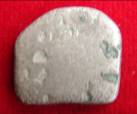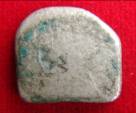A large amount of Epigraphy and various types of coins are circulated in ancient Sri Lanka are scattered in various areas of the island. The backing extended by these documents and coins which give correct information on various historical events to build the history of Sri Lanka is really praiseworthy.
Legal possession of these documents and coins enriched with invaluable historical importance has been entrusted to the Epigraphy and Numismatics Division. To inculcate awareness among the public that a more rationalized history can be written embodying the events and activities that are hidden in these archives and coins and to preserve then for posterity is the role of the Epigraphy and Numismatics Division.
Future vision, mission and the role of this division have been formulated with the intention of inheriting the Epigrapical and numismatic heritage to the future generation of Sri Lanka.
Role
- Identification and registration of all archives and coins.
- Taking stumpage of archives
- Preserving and maintenance of field data and facsimiles collected.
- Reading of Archives
- Conducting research
- Preparation of basic work required to declare results of research
- Forwarding necessary recommendations and data to relevant sections for the protection of archives.
Projects
- Implementation of various projects by the Epigraphy and Numismatics Division.
- Project of indexing inscriptions of Sri Lanka at district level.
- Project of recording historical Epigraphy
- Project of indexing coins.
- Publication of inscriptions project.
- Inscriptions, translations and name boards preparation project
- Copying and Registration of Inscriptions Project.
Furnishing Information |
||
| Telephone number | - | +94 112 - 2695609 |
| Address | - | Epigraphy and Numismatics Division, Sir Marcus Fernando Avenue, Department of Archaeology, Colombo 07. |
Epigraphy
Any writing or symbols written on any surface is known as epigraphy. Sri Lankans very often have used surfaces of stones for writing letters. Further, clay, paper, wood and metals such as gold, silver, copper etc. have also been used as media for writing. Periods of evolution of Sinhala letters;
- Early Brahmi
- Late Brahmi
- Transitinal Brahmi
- Medieval Sinhala
- Modern Sinhala
Letters written in languages such as Tamil, Chinese, Arabic, Persian, Sanskrit and Pali have also been found. These letters reveal the strong foreign influence Sri Lanka had to undergo.
Expansion of Inscriptions |
Evolution of Letters in Sri Lanka |
|||
|
|
|
|
||
Majority of epigraphics mention the donations made to Buddhist monasteries and the Sagha by ancient kings as well as common people. The epigraphy offer praiseworthy contribution in revealing the economic, political and social status of ancient Sri Lanka.
Ancient coins in Sri Lanka
Dagabas, painting, statues, tanks, anicut etc. created by our forefathers reveal important milestones of our history to the rest of the world. During the process of constructing these colossal creations, they also manufactured small coins which illustrate the excellence of our heritage. Archaeological research have revealed the ancient coins hidden underneath the earth as results of activities of ancient humans, are so numerous as to prepare a directory of coins and these coins help immensely to interpret our history.
The oldest evidence regarding the basic transactions that occurred in our country comes from the Messolithic society.
Use of coins in Sri Lanka had taken place by the 3rd century B.C. Designations relating to manufacture of coins such as “Rupadaka” (Director of coins), “Rupavapara” (Officer approving coins) found in cave inscriptions bear testimony to the fact that the manufacture of coins took place according to an organized plan. The oldest record on circulation of coins in Sri Lanka comes from the cave inscriptions.
Sri Lanka’s involvement in local and foreign trade was a strong factor that contributed in circulation of coins in the country. Coins used in the past reveal a lot of information about the contemporary society. Several types of coins used in ancient Sri Lanka have now been identified and classified as local and foreign coins in chronological order.
Local coins
With the production of metal, pieces of metal of varied shapes have been used as media of exchange. Subsequently coins of systematic shapes evolved.
- Punched coins
- Swastika coins
- Coins with the figure swastika
- The coin with tree and swastika
- The coin with lion and swastika
- Lion coins
- Bull coins
- Lakshmi coins
- Ran kahawanuwa and its parts
- Medeaval copper massa coin
- Sethu coins of Jaffna
- Massa coins
- Panama
- Angutumassa / hook coin
Foreign coins
Sri Lanka even in the distant past had been a trade centre to both Eastern and Western countries. Apart from trade activities, Sri Lanka was frequently subject to foreign influence due to diplomatic relations, tourism and imperialist invasions. This fact is further established by coins found in various parts of Sri Lanka.
- Roman
- Chola-Pandya coins (Chola-Pallava)
- Chinese
- Arabic
- Pagodi
- Portuguese
- Dutch
- British
Punched Kahapanas
Punched Kahapana can be identified as the oldest coin used in Sri Lanka. These coins were made of copper and silver. Originally iron splinters cut to the required size had been used. Later using circular, oval and rectangular moulds, coins of different shapes with identical weight had been made. Size of a coin was about 1-1.5 centimeters and the weight was 45 grains. There had been many designs on the obverse. These coins had been in use during the period, 3rd century B.C. to 1st century A.D.
 |
 |
| Obverse | Reverse |


 Epigraphical / Numismatic
Epigraphical / Numismatic




















